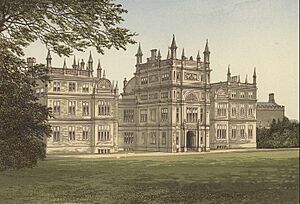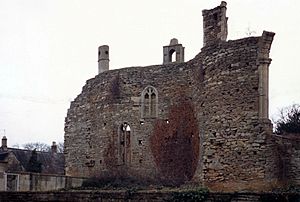Corsham Court facts for kids
Quick facts for kids Corsham Court |
|
|---|---|

The south front of Corsham Court.
|
|
| Location | Corsham, Wiltshire, England |
| Built | 1582 |
| Built for | Thomas Smythe |
|
Listed Building – Grade I
|
|
| Designated | 20 December 1960 |
| Reference no. | 1022004 |
| Lua error in Module:Location_map at line 420: attempt to index field 'wikibase' (a nil value). | |
Corsham Court is a grand English country house located in a beautiful park in Corsham, Wiltshire. The park was designed by the famous landscape architect Capability Brown. The house is known for its amazing art collection, which started with paintings inherited by Paul Methuen in 1757.
Today, Corsham Court is the home of James Methuen-Campbell, who is the Baron Methuen. His family has lived in the house for eight generations.
Contents
A Royal Home of the Past
Long ago, during the time of the Saxon kings, Corsham was a royal estate, also known as a manor. It was said to be a home for King Ethelred the Unready. After William the Conqueror became king of England, the manor was passed down through the royal family for many years.
In the 14th and 15th centuries, the house was often given to the Queens of England. Later, during the 16th century, it belonged to two of King Henry VIII's wives: Catherine of Aragon and then Katherine Parr.
The house we see today was first built in 1582 by Thomas Smythe, after the estate left the royal family during the reign of Queen Elizabeth I.
The Methuen Family Era
The house was bought in 1745 by Sir Paul Methuen for his cousin, who was also named Paul Methuen. The house has been the home of the Methuen family ever since.
'Capability' Brown's Grand Design
Between 1761 and 1764, the family hired Lancelot 'Capability' Brown, a very famous architect, to make the house bigger and redesign the park. Brown was known for creating natural-looking landscapes.
He kept some of the old Elizabethan parts of the house but doubled its size. He added new wings on each side. The east wing included a huge Picture Gallery to display the family's art collection. The west wing had a library and new kitchens.
For the park, Brown had big ideas. He used a ha-ha, which is a type of sunken fence, to separate the park from the gardens. This meant the family could have a clear view of the landscape from the house without any fences in the way. He also planned a large lake and built a Gothic-style Bath House.
Brown also created a "Great Walk" that stretched for a mile through groups of trees. He planted many trees around the park to hide nearby roads and fields, making the view from the house look like a perfect countryside painting.
More Changes by Nash and Repton
In 1795, another famous landscape designer, Humphry Repton, was hired to finish the work Brown had started. A year later, architect John Nash was hired to redesign the north side of the house in a popular Gothic style. Nash also added his own touches to the grounds, including the library.
Unfortunately, much of Nash's work had to be torn down and rebuilt later. It was discovered that he had used poor-quality wood that wasn't properly dried. All of his work, except for the library, was replaced between 1844 and 1849.
Repton and Nash worked together to finish the park. They planted many types of trees, including American oaks and the beautiful oriental plane tree. They also built a "folly" ruin on the grounds. A folly is a building made just for decoration, and this one was designed to look like ancient ruins.
A School for Artists
After World War II, the Bath Academy of Art needed a new home because its buildings had been destroyed. In 1946, Lord Methuen, who was a talented painter himself, invited the school to move to Corsham Court.
For 40 years, until 1986, the house was filled with art students and teachers. Many famous British artists taught here, including Kenneth Armitage, Terry Frost, and Howard Hodgkin. In 2008, the art school, now part of Bath Spa University, returned to Corsham Court to set up studios for art students and researchers.
Corsham Court on the Big Screen
Because of its historic beauty, Corsham Court has been used as a location for filming movies.
In 1975, scenes for the film Barry Lyndon were shot here. The house was also featured in the 1993 movie The Remains of the Day.



